Appendix P
Chemical Fume Hoods and Other Local Ventilation Devices
The chemical fume hood is considered an important means of protection from hazardous chemical exposure. General room ventilation does not effectively protect laboratory personnel from inhalation of hazardous levels of chemical vapors, fumes and dusts. Therefore, laboratory personnel should/are required to use a chemical fume hood or other containment devices when working with potentially hazardous chemicals.
This appendix is intended to help laboratory workers understand the limitations and proper work practices for safely using fume hoods and other local ventilation devices.
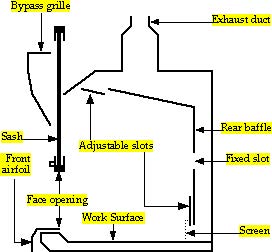
-
-
- How a Fume Hood Works
A fume hood is a ventilated enclosure in which gases, vapors and fumes are contained and diluted by an induced flow of air coming through the face of the hood. An exhaust fan situated on the top of the laboratory building pulls the air and airborne contaminants contained in the hood through ductwork and safely exhaust them to the atmosphere.
The typical fume hood is equipped with an interior baffle and movable front sash (framed window). The sash travels the plane of the hood face and provides protection to the hood user by acting as a barrier between the worker and the experiment.
The slots and baffles direct the air being exhausted. In many hoods, they may be adjusted to allow the most even flow. It is important that the baffles are not closed or blocked since this blocks the exhaust path.
The airfoil or beveled frame around the hood face allows more even airflow into the hood by avoiding sharp curves that can create turbulence.
- Fume Hood Operating Performance
- Fume Hood Performance Checks
- Fume hoods are factory tested in accordance with ASHRAE/ANSI standard 110 before leaving the manufacturer to ensure proper performance and are installed according to manufacturer specifications.
- AU Facilities perform preventative maintenance on fume hood motors, belts, controls, etc. on an annual basis. A maintenance record is kept at Heating Plant and NYSCC Maintenance.
- EH&S will manage annual fume hood inspections for the following:
- average face velocity of the hood and places a dated survey tag on hood, – places sash height markers at which the average face velocity is 80 fpm and 125 fpm,
- places sash height markers at which the average face velocity is 80 fpm and 125 fpm,
- air flow patterns and leakage using smoke test,
- airflow direction indicators on hood sash, replaces indicator if missing,
- 14 inch maximum height sash marker, replaces marker if missing,
- spills, airflow blockage, disabled alarms and sash stops.
- average face velocity of the hood and places a dated survey tag on hood, – places sash height markers at which the average face velocity is 80 fpm and 125 fpm,
- Laboratory personnel must evaluate hood before each use to:
- verify airflow into the hood by making sure the airflow direction indicator is blowing into the hood. Also check any air monitoring device if the hood is equipped with one.
- immediately report any malfunction to the LSF/PI or send a work order, requesting repair, to the proper facility.
- place a dated “do not use” sign on the malfunctioning hood.
- verify dated (within one year of current date) EH&S survey tag and sash markers are present.
- if EH&S tag is missing or out of date or sash markers are missing – place a dated “do not use” sign on the malfunctioning hood and contact EH&S 2190.
- verify airflow into the hood by making sure the airflow direction indicator is blowing into the hood. Also check any air monitoring device if the hood is equipped with one.
- Fume Hood Performance Checks
- Location
The location of the fume hood affects its efficiency. Ideally, fume hoods should be located in an area of minimal traffic. When a person walks by a fume hood, turbulence can be created causing contaminants to be drawn outside the hood. Also, if the air diffuser is located directly above the fume hood, air turbulence may be created causing contaminants to escape into the room. The air flow into the room has an effect on the fume hood. All doors should be closed to maintain the negative pressure of the lab with respect to the corridor. This ensures that any contaminants in the lab will be exhausted through the fume hood and not escape into the hallway.
- Face velocity
The average velocity of the air drawn through the face of the hood is the face velocity. It is a measurement of containment efficiency. Face velocities that are either too low or too high reduce the containment efficiency of a fume hood placing the user at risk of exposure. Based on a number of studies and the recommendations of several laboratory safety guidance documents, the following face velocity criteria are recommended:
- Above 150 fpm: Unacceptable for laboratory use.
- 95-125 fpm: Provides adequate control of inhalation exposure to most hazardous substances, including radioactive materials and particularly hazardous substances
- 80-95 and 125-150 fpm: Adequate for manipulation of laboratory quantities of hazardous materials except radioactive materials and particularly hazardous substances.
- Below 80 fpm: Use approved by EHS on case by case basis, based on activities, placement of hood, smoke tests, etc.
- Face velocity sensors and alarms
Many of the newer hoods are equipped with sensors that will trigger an alarm if the face velocity falls below an acceptable work range. The alarm indicates:
- the sash has been raised to a height at which the hood can no longer exhaust a sufficient amount of air,
- the building air exhaust system is not working properly,
- or there has been a power outage.
- When a hood alarm sounds, no chemical work should be performed until the exhaust volume is increased.
- Do not attempt to stop or disable hood alarms.
- Place a dated “do not use” sign on the hood and send a work order to the proper university facility.
- Face velocity sensors and alarms
- Sash position
- Do not work with hazardous chemicals with the sash positioned above the 14 inch mark
- For constant air volume hoods (CAV) without face velocity controls:
- sash must be properly positioned to produce the recommended face velocity, which often occurs only over a limited range of sash positions.
- this range is determined and identified by markers placed by EH&S during fume hood testing.
- keep sash closed when hood is not in use.
- sash must be properly positioned to produce the recommended face velocity, which often occurs only over a limited range of sash positions.
- For hoods with face velocity controls:
- sash must be positioned at the height which registers the recommended face velocity on air flow meter
- it is imperative to keep the sash closed when the hood is not in use.
- For constant air volume hoods (CAV) without face velocity controls:
- Do not work with hazardous chemicals with the sash positioned above the 14 inch mark
- How a Fume Hood Works
- Air flow direction indicators
- A ribbon of light weight material such as tinsel, Teflon tape or Kim-wipe is taped to the bottom corner of the sash by EH&S during annual fume hood check. The indicator shows the direction of airflow, and is the only way to know for certain that air is being drawn into the hood. Sometimes the air flow is reversed by accident during maintenance.
- Air flow indicators do not determine face velocity; they only indicate that air is being exhausted through the fume hood.
- If inward movement is not detected, place a “do not use” sign on the hood and send a work order to the proper facility, AU Physical Plant.
- Hood Types
There are many types of hoods, each with its own design and function. To identify which type of hood is present in your lab, a list of definitions describing hood features and their advantages and disadvantages is provided below.
- Constant air volume - Conventional hood
A constant air volume (CAV) hood is the traditional, older style, less elaborate hood design used for general protection of the lab worker. Because the amount of exhausted air is constant, the face velocity of a CAV hood is inversely proportional to the sash height. That is, the lower the sash, the higher the face velocity. CAV hoods can be installed with or without a bypass provision which is an additional opening for air supply into the hood.
- Conventional hood without a bypass
Some conventional hoods do not have a provision for a bypass. They consist of an enclosed cabinet with a connection for an exhaust duct and a movable sash on the front.
- Conventional bypass fume hood
The bypass is located above the sash face opening and protected by a grille which helps to direct air flow. The bypass is intended to address the varying face velocities that create air turbulence leading to air spillage. The bypass limits the increase in face velocity as the sash nears the fully closed position, maintaining a relatively constant volume of exhaust air regardless of sash position.
CAV hoods
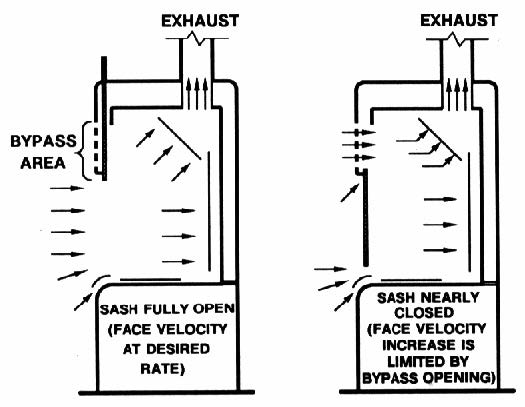
- Conventional hood without a bypass
- Constant air volume - Conventional hood
- Auxiliary air hood
This type of fume hood, sometimes referred to as a makeup air fume hood, was developed as a variation on the bypass fume hood and reduces the amount of conditioned room air that is consumed. The auxiliary fume hood is a bypass hood with the addition of direct auxiliary air connection to provide unconditioned or partially conditioned outside makeup air. Auxiliary air hoods were designed to save heating and cooling energy costs, but tend to increase the mechanical and operational costs due to the additional ductwork, fans, and air tempering facilities. In general, installation of this type of hood is discouraged since the disadvantages usually outweigh the benefits.
Auxiliary air hoods
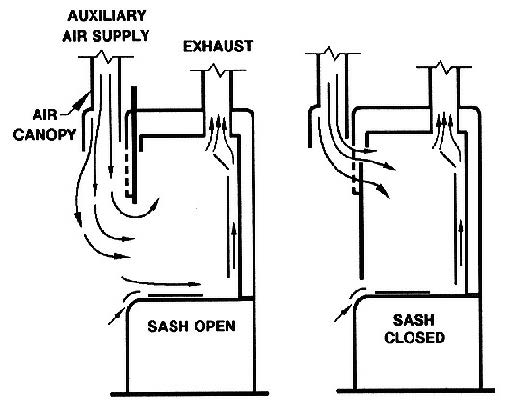
-
- Variable air volume (VAV) hood
A VAV hood maintains a constant face velocity regardless of sash position. VAV hoods are fitted with a face velocity control which varies the amount of air exhausted from the fume hood in response to the sash opening to maintain a constant face velocity. This control system significantly increases the hood’s ability to protect against excess face velocity turbulence which leads to contaminated air spillage. VAV hoods reduce the total quantity of supply and exhaust air to a space when not needed, thereby reducing total operating costs.
VAV hoods
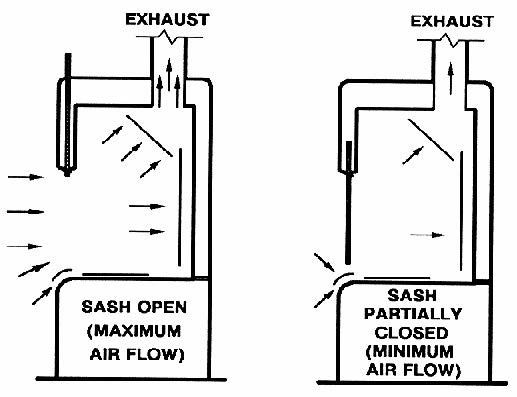
- Specialty Lab Exhaust Systems
- Walk-in hoods
Walk-in hood sits directly on the floor and are characterized by a very tall and deep chamber that can accommodate large pieces of equipment. Walk-in hoods may be designed as conventional, bypass, auxiliary air, or VAV.
- Fume exhaust connections: "snorkels"
Fume exhaust duct connections, also called snorkels, elephant trunks or flex ducts, are designed to be somewhat mobile allowing the user to place it over the area needing ventilation. For optimal efficiency, these connections must be placed within six (6) inches of an experiment, process, or equipment. These funnel-shaped exhausts aid in the removal of contaminated or irritating air from the lab area to the outside.
- Canopy hoods
Canopy hoods are horizontal enclosures having an open central duct suspended above a work bench or other area. Canopy hoods are most often used to exhaust heat generated from an oven or an area that is too large to be enclosed within a fume hood. The major disadvantage with the canopy hood is that the contaminants are drawn directly past the user's breathing zone.
- Slot Hoods
There are many types of slot hoods, each suited for different types of operations. In general, a slot hood requires less airflow than a canopy hood and is much more effective than an elephant trunk or canopy hood, when installed properly.
Slot hoods are best used for operations that require more working room than a fume hood and where a limited number of low toxicity chemicals are used. The placement of the opening(s) and the velocity of airflow are based on the application, particularly dependent upon the vapor density of the chemical(s).
Examples of good uses for slot hoods are darkrooms and acid dipping operations.
- Downdraft Hoods
Downdraft hoods or downdraft tables are specially designed work areas with ventilation slots on the sides of the work area. This type of system is useful for animal perfusions and other uses of chemicals with vapor densities heavier than air.
- Glove boxes
Glove boxes are used when the toxicity, radioactivity level, or oxygen reactivity of the substance pose too great a hazard for use within a fume hood. The major advantage of the glove box is protection for the worker and the product.
Glovebox
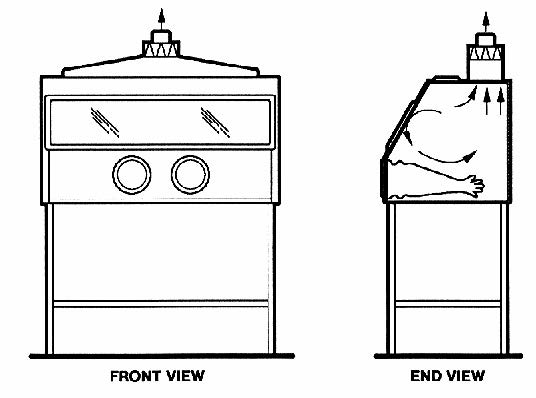
- Perchloric Acid and radioisotope fume hoods
Working with Perchloric Acid and/or volatile radioisotopes requires a specifically designed fume hood. Refer to Perchloric Acid Appendix O. Biology does have a hood approved for radioisotopes. As of September 2008, there is not a Perchloric Acid fume hood on campus.
- Toxic Gas Cabinets
Highly toxic or odorous gases should be used and stored in gas cabinets. In the event of a leak or rupture, a gas cabinet will prevent the gas from contaminating the laboratory.
Gas cabinets should be connected to laboratory exhaust ventilation using hard duct, rather than elephant tubing, since such tubing is more likely to develop leaks. Coaxial tubing should be used for delivering gas from the cylinder to the apparatus. Coaxial tubing consists of an internal tube containing the toxic gas inside another tube. In between the two sets of tubing is nitrogen, which is maintained at a pressure higher than the delivery pressure of the toxic gas. This ensures that, in the event of a leak in the inner tubing, the gas will not leak into the room.
- Flammable or corrosive material storage cabinets may comprise the bottom supporting structure of the fume hood. They can be vented or non-vented enclosures used primarily for storage of flammable or corrosive materials. If vented, the storage cabinet must be connected to the hood exhaust. The corrosive storage cabinet is designed with a protective lining and secondary containment to inhibit chemical corrosion.
- Walk-in hoods
- Safe Work Practices
The health and safety of laboratory personnel and building occupants is the primary goal of EH&S and laboratory management. Fume hoods, if installed and used properly, help achieve this goal by capturing harmful chemical vapors and airborne substances and exhausting them to the outside air.
- To work safely with fume hoods:
- Follow proper procedures for working alone, unattended operations, and PHS.
- Know the hazards of the chemical and use work methods that help reduce exposure.
- Substitute toxic chemicals with less hazardous materials whenever possible.
- Perform all work at least six inches inside the hood.
- Keep the hood sash as low as possible within the proper face velocity range.
- User's face should never break the plane of the sash opening; view the procedure through the glass. Position the sash so that work is performed by extending the arms under the sash, keeping the glass between the worker and the chemical source.
- Do not move or remove sash markers.
- Do not override or disable sash stops or air monitoring alarms.
- Have a general awareness of the operation of your hood and be aware of any differences in visual or audible cues that may imply a change in function.
- Keep lab doors closed to ensure negative room pressure to the corridor and proper air flow into the hood.
- Keep the slots of the baffle free of obstruction.
- Run cords and hoses underneath the airfoil.
- Place equipment on 2 inch blocks to minimize turbulence and allow for proper air flow to the baffle.
- Avoid rapid movements in front of the hood including opening and closing the sash rapidly and swift arm and body movements in front of or inside the hood. These actions may increase turbulence and reduce the effectiveness of fume hood containment.
- A fume hood is not a storage area. Only equipment and chemicals being used in an ongoing experiment should be in the hood.
- Keep sash closed when not in use to minimize energy usage.
- In the event of a hood failure during chemical use:
- Turn off power to equipment in the hood.
- Stabilize the chemical source as much as possible to minimize release.
- Close hood sash.
- Post a dated sign stating “hood failure, experiment in progress” to notify other occupants of the laboratory.
- Notify the LSF/PI and/or send a work order to AU Physical Plant or NYSCC Maintenance.
- If hazardous chemicals are released from the hood in a quantity that presents a fire hazard or high health hazard, evacuate the area and call for emergency assistance. If the released material presents a lower risk scenario (no fire hazard and/or lower health hazard), call EH&S.
- To work safely with fume hoods:
- Common Misuses and Limitations
Used appropriately, a fume hood can be a very effective device for containment hazardous materials, as well as providing some protection from splashes and minor explosions. Even so, the average fume hood does have several limitations.
- Particulates: A fume hood is not designed to contain high velocity releases of particulate contaminants unless the sash is fully closed.
- Pressurized systems: Gases or vapors escaping from pressurized systems may move at sufficient velocity to escape from the fume hood.
- Explosions: A standard chemical fume hood is not capable of completely containing explosions, even when the sash is fully closed. If an explosion hazard exists, the user should provide anchored barriers, shields or enclosures of sufficient strength to deflect or contain it. Such barriers can significantly affect the airflow in the hood.
- Perchloric Acid: A conventional fume hood must not be used for Perchloric Acid. Perchloric Acid vapors can settle on ductwork, resulting in the deposition of perchlorate crystals. Perchlorates can accumulate on surfaces and have been known to detonate on contact, causing serious injury to researchers and maintenance personnel. Specialized Perchloric Acid hoods, made of stainless steel and equipped with a washdown system must be used for such work. As of September 2008, there is not a Perchloric Acid fume hood on campus.
- Tubing for Exhaust: Tubing is frequently used to channel exhaust to the hood from equipment located some distance away. This is not an effective control method.
- Connections to the Exhaust System: Occasionally, lab personnel may need local exhaust ventilation other than that provided by an existing fume hood. A new exhaust device/unit may not be connected to an existing fume hood without the explicit approval of the Physical Plant or NYSCC Maintenance facilities and EH&S. Adding even the simplest exhaust unit, without adequate evaluation and adjustment, will usually result in decreased performance of the existing hood and/or inadequate performance of the additional unit.
- Microorganisms: Do not use a chemical fume hood for work involving harmful microorganisms. See the AU Biosafety Manual (pending) for more information.
- Highly Hazardous Substances: A well designed fume hood will contain 0.999 - 0.9999% of the contaminants released within it when used properly. When working with highly dangerous substances needing more containment than a fume hood offers, consider using a glove box.
- Pollution Control: An unfiltered fume hood is not a pollution control device. All contaminants that are removed by the ventilating system are released directly into the atmosphere. Apparatus used in hoods should be fitted with condensers, traps or scrubbers to contain and collect waste solvents or toxic vapors or dusts.
- Waste Disposal: A fume hood should not be used for waste disposal. It is a violation of environmental regulations to intentionally send waste up the hood stack.
References
ACGIH Committee on Industrial Ventilation. 1995. "Industrial Ventilation: A Manual of Recommended Practice, 22nd ed." American Conference of Governmental Industrial Hygienists, Inc., Cincinnati, OH
American Industrial Hygiene Association. 1992. "American National Standard for Laboratory Ventilation." ANSI/AIHA Z9.5 Fairfax, VA
Associated Air Balance Council. 1982. "National Standards for Total System Balance, 4th ed." Associated Air Balance Council, Washington, DC
Committee on Prudent Practices for Handling, Storage, and Disposal of Chemicals in Laboratories. 1995. "Prudent Practices in the Laboratory, Handling and disposal of Chemicals." National Academy Press, Washington, DC
DiBerardins, Louis J., Baum, Janet S., First, Melvin W., Gatwood, Gari T., Groden, Edward F., Seth, Anand K. 1993. "Guidelines for Laboratory Design: Health and Safety Considerations, 2nd ed." John Wiley and Sons, Inc., New York, NY
Division of Environmental Health and Safety. 1989. "University of Illinois at Urbana-Champaign Health and Safety Guide 7-A." Division of Environmental Health and Safety, Urbana-Champaign, IL
Gershey, E.L., Wilkerson, Amy, Joao, R.V., Volin, C.E., Reiman, J.S. 1996. "Chemical Hood Performance: Standards, Guidelines, and Recommendations." Chemical Health & Safety, November/December.
Plog, Barbara A., Niland, Jill, Quinlan, Patricia J. 1996. "Fundamentals of Industrial Hygiene, 4th ed." National Safety Council, Itasca, IL
Scientific Apparatus Makers Association. 1980. "SAMA Standard for Laboratory Fume Hoods." Scientific Apparatus Makers Association, Washington, DC

